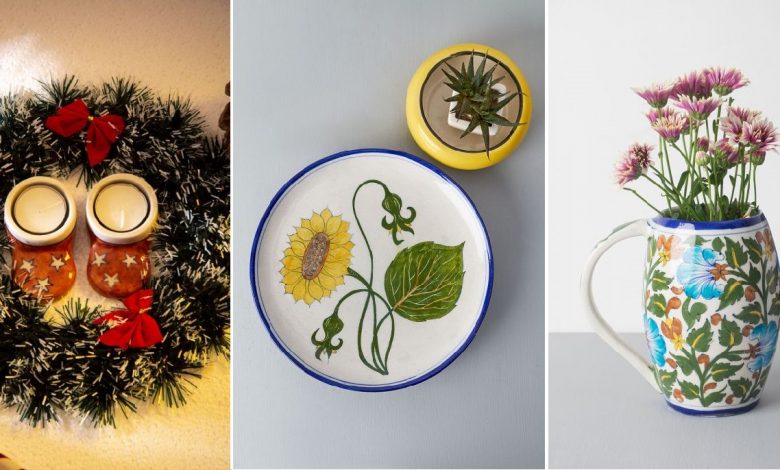Blue Pottery: A Tale of Craft

As you put your step on the soil of Rajasthan you will be mesmerized by the bright colours around you. Jaipur is one of the biggest and oldest cities that has been the cradle of art for centuries, you will find many forms of art surrounding the city as you move around it taking a rickshaw ride. These forms of art include lac bangles, gems and metal jewellery, bandhej work, miniature paintings, puppets, jootis and most importantly blue pottery. Coming to Jaipur and not taking a blue pottery home is sinful. The undying beauty of the blue pottery is undeniably enthralling.
The beautiful pieces narrate the tale of craft with its floral and fauna motifs. Its unique appearance comes from the Egyptian paste that is glazed and is made on low fire. Its dough is made using quartz stone powder, powdered glass, gum, borax and Multani mitti. Its name comes from the turquoise blue colour that is used in the pottery.
These fragile pieces are an epitome of elegance and artistry. This epiphany of craft is sure to spellbind you with its bewitching beauty and an unending array of hues and beautiful motifs.
No Clay Pottery
The charming piece of pottery is of turko-persian origin. What makes them even more intriguing is the fact that it is the only pottery in the world that is not made of clay. As these are prepared on low fire using eqyptian paste and other things but not clay, they become very fragile. You can have ashtrays, flower vases, plates, bowls, coaster sets, tiles and many more and can make you fall in love with them once you behold them.
It goes back to centuries
These mavericks of art are awe-striking but these were originally not from India. These pieces of art are too old to imagine and have been a part of India since the 14th century. These were initially made by Mongol artisans. They are a combination of Chinese glazing technology and Persian motives. Initially, it was used to decorate tombs, mosques, palaces and places in Central Asia but it went through a role reversal after arriving in India. These blue pottery reached Jaipur in the 17th century and took the shape of pottery from here. It is believed to be made very popular by the Mughal emperors.
An enthralling tale behind its popularity
It is believed that the then king of Jaipur Raja Sawai Ram Singh II attended a kite flying competition where two brothers who participated in the competition brought the royal kites down. The king was really impressed with the brothers and wanted to know the secret of their victory. The brothers told him that they were potters and used a blue-green glass on the kite strings that they use while making the pots. The king got really fascinated with the story. Thus he decided to give this art form a push and therefore he invited the brothers to Jaipur and asked them to teach the art form to others as well so that it would flourish.
The colour says it all
The colours used in the pottery is what makes it look divine. But from where these colours come from? The blue colour is from cobalt oxide while the potteries are given its green colour from copper oxide and white. With the passage of time new colours got added to the pottery to add variations to it and colours like yellow, and brown also made its place in the pottery.
The motifs on the pottery
Initially, when the art form was new in Jaipur only flower and animal motifs were made to design the blue pottery but with changing times and the changing demands of the market contemporary designs were also added to it. These include floral designs, geometric patterns, animals, birds, Hindu gods and goddesses as well giving the Persian motifs the all-new form.
The revival of the art from getting extinct
The blue pottery Jaipur is really popular among people and the royal families but after the master potters refused to share the secret of making these beautiful art-pieces with their fellow potters it did not flourish and reached the verge of extinction. But with the combined efforts of the queen of Jaipur Her Royal Highness Gayatri Devi, muralist and painter Kripa Singh Shekhawat it got revived in the 1950s and became the livelihood of many artisans in Jaipur.
You can easily avail these decorative items online and in markets as it has become a favourite of many with the passing time. Because of its growing popularity, it is exported to many parts of the world and is loved by many.
With the kind of labour and time put in the making of this pottery, it is undeniably one of the finest pottery art that can allure anybody. This timeless beauty has survived the passage of time is the sheer love of the people for blue pottery. All we can do to contribute to these timeless pieces is to keep alleviating the spirit of the craftsmen by purchasing them. You just need to handle them with care and add to the beauty of your home and office with these extraordinary creations of art.





